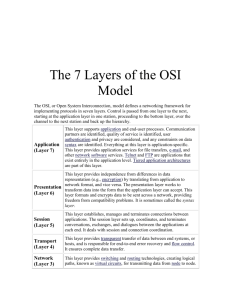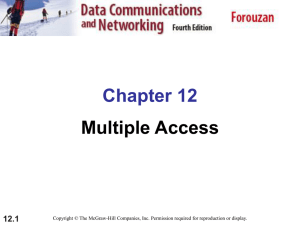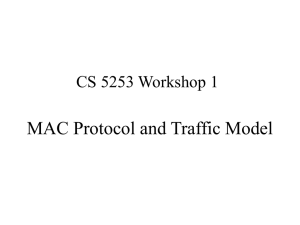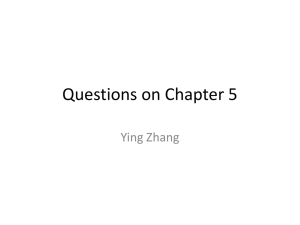CS 294-7: Media Access— Aloha and CSMA Prof. Randy H. Katz CS Division
advertisement
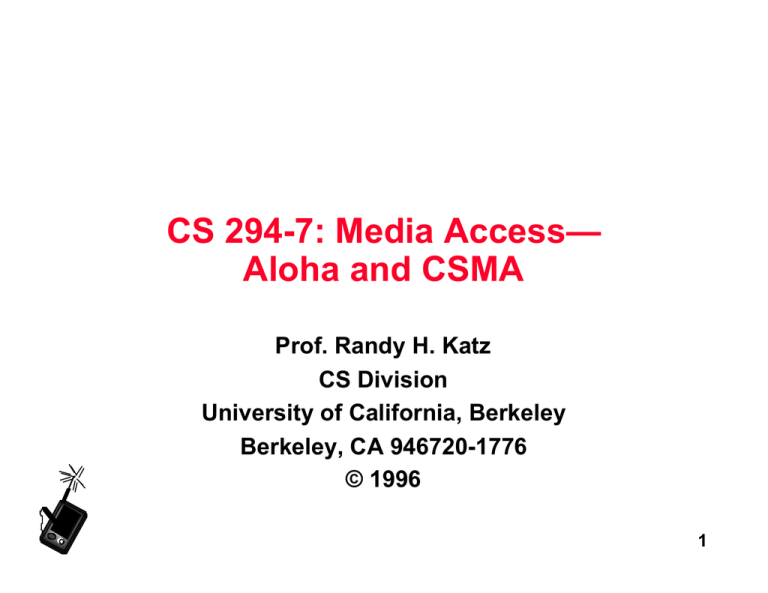
CS 294-7: Media Access— Aloha and CSMA Prof. Randy H. Katz CS Division University of California, Berkeley Berkeley, CA 946720-1776 © 1996 1 Media Access • Aloha – – – – – Transmit when desired Positive ACK from receiver on independent link Back off and retransmit if timeout Slotted scheme reduces chance of collision Aka “random access channel” • Carrier Sense/Multiple Access (CSMA) – Listen before transmit – Back off and retransmit if collision detected • Inhibit Sense/Multiple Access – – – – Base station transmits busy tone Transmit when not busy Back off and retransmit if collision Aka Digital Sense Multiple Access (DSMA) 2 Media Access • Hidden Terminals – Cannot hear each other – Adds complexity to carrier sense methods – Renders carrier detection techniques ineffective • Near-Far Problem – Near-by terminal over powers signal from the far-away terminal – Unfair access to channel: “Capture” effect Hidden terminal disrupts the communications 3 Media Access Satellite Systems—TDMA. CDMA Cellular Systems—TDMA, CDMA WLANs w/ Base Stations—SS Packet radio/ad hoc networks— no base station infrastructure Broadcast/Multicast Direction Demand Assigned Multiple Access (DAMA) request channel Steady traffic: static assignment Slowly varying traffic: demand assignment Random/ Multiaccess Direction “Multi-Access Problem” 4 Aloha Channels Classical Aloha B A C D C D Time Collision Retransmission Waiting Time Slotted Aloha A D B C D C Collision 5 Aloha Channel Utilization Channel utilization: = T = Total time sending original packets/total time User initiated packets per second: Packet transmission time: T Packets per second, including retransmissions: ’ ( ’ > ) Probability of n packets originating in a second (Poisson): P(n) = ’n e- ’ / n! Probability of no packets in time duration t: [P(n=0)]t = e- ’ t If packet is to be sent at time t0, there can be no transmission at times (upto) t0 ± T: [P(n=0)]2T = e- ’ 2T Fraction of retransmitted packets: R = 1 - e- ’ 2T = ’ [1 - R] = e- ’ 2T = T = ’ T e- ’ 2T Mean # of retransmissions N = 1+R+R2+R3+… = 1/(1-R) = e- ’ 2T = (LogeN)/2N, reaches its maximum value at 1/2e = 0.184 6 Aloha Channel Utilization 5 4 Mean # of Times a packet is transmitted, N = loge N 2N 3 2 1 0 0.05 0.10 0.15 0.184 Usable Channel Utilization, 7 Slotted Aloha Channel Utilization Channel utilization: = T Packets per second: Packet transmission time: T Packets per second, including retransmissions: ’ Probability of n packets originating in a second (Poisson): P(n) = ’n e- ’ / n! Probability of no packets in time duration t: [P(n=0)]t = e- ’ t Fraction of retransmitted packets: R = 1 - e- ’ T = ’ [1 - R] = e- ’ T = T = ’ T e- ’ T Mean # of retransmissions N = 1+R+R2+R3+… = 1/(1-R) = e- ’T = (LogeN)/N, reaches its maximum value at 1/e = 0.362 Utilization can be improved (but mean delay is increased) by using packet reservation schemes (up to 0.80!) 8 Slotted Aloha Channel Utilization 5 4 Mean # of Times a packet is transmitted, N = loge N N 3 2 1 0 0.10 0.20 0.30 0.368 Usable Channel Utilization, 9 Demand Assigned Multiple Access (DAMA) • “Burst Reservation” System – – – – Senders request reservation for future time slot When slot time comes, transmit without contention Trades higher utilization for higher latency Commonly used in satellite systems Transmission Delay Channel O/H needed for reservation/ack msgs Reservation System w/ ALOHA reservations 3 Round trip times: Rqst/Ack/Xmit Reservation System w/ RR reservations Slotted ALOHA 0.3 0.83 Channel Utilization 10 Carrier Sense Multiple Access • Wired LANs: CSMA/CD—Collision Detection – Listen to carrier before transmit – When carrier is quiet, transmit while reading back transmitted signal – If read back ≠ transmit, then collision; back off and retransmit later – Problem for wireless: transmitter may not be able to detect the collision (hidden terminal problem) 11 Expected Features Wireless LAN MAC (IEEE 802.11) • • • • • • • • • • Throughput—high effective throughput Delay—predictable delays Transparency—diverse underlying PHY layers Multimedia Support—time bound services Fair Access—near-far problem Battery Power Consumption—sleep mode Maximum Number of Nodes Robustness in Collocated Networks Support for Mobility—low latency handoff Support for Ad Hoc Networking 12 Expected Features Wireless LAN MAC (IEEE 802.11) • • • • • • • • • Unauthorized Access/Impact on Performance Support for Broadcast/Multicast Critical Delays Limit Coverage Area—sync problems Insensitivity to Capture Support Priority Traffic Asymmetric Access—Downlink vs. uplink Preserve Packet Order Works over wide range of distances, # of nodes Limit Physical Layer Complexity 13 Carrier Sense Multiple Access • CSMA/CA—Collision Avoidance – When carrier is quiet, WAIT a random time and try again – If still quiet, then transmit – No guarantee that just because the transmitter obtains the medium that the receiver can hear the transmission • Distributed Foundation Wireless MAC (DFW MAC—IEEE 802.11) – RTS: Request to send, transmitter to receiver: sender wishes to communicate with destination – CTS: Clear to send, receiver to transmitter: destination ready and available to receive from sender – DATA/ACK frame by frame; NAK indicates frame corrupted – RxBUSY: Receiver Busy, try again later 14 DFW MAC Idle Frame to send/RTS Time Out/RTS RxBusy Wait CTS/RxBusy ACK Idle Data/ NAK Data/ ACK RTS/CTS CTS/Data Wait ACK/NAK NAK/ Data Source Time Out/Data Wait Data RTS/ RxBusy Destination 15 Randomly Addressed Polling • Use distributed polling algorithm, BS to MH, to avoid/ minimize collisions on the uplink – Invitation to contend: BS broadcasts READY to receive signal. – Contention scheme: MHs wishing to transmit generate random number (dynamic address) and transmit these simultaneously. These are sent orthogonally, using CDMA or FDMA techniques. – Coordination scheme: Exchange of random numbers repeats in multiple stages in an effort to detect the distinct number of ready-tosend MHs. – Uplink packet transmission: BS chooses an address with which to poll the MHs (collision is possible since two MHs may have generated same random number). – Acknowledgement: BS sends positive ACK if packet received successful or negative ack if not received, polls another MH immediately. – Once all random numbers have been used in polling, the process repeats from the beginning – Claim 70-90% of channel throughput can be achieved, compared with 45-60% in CSMA schemes 16 Inhibit Sense Multiple Access • CDPD MAC Layer: Digital Sense Multiple Access MD-ES MD-ES MD-ES MD-BS Forward Link Reverse Link – Forward link: scheduled by BS, signals channel idle/busy – Reverse link: contention access with back-off BS signals frame by frame ACK—contending stations can determine collision from this forward link signal 17

